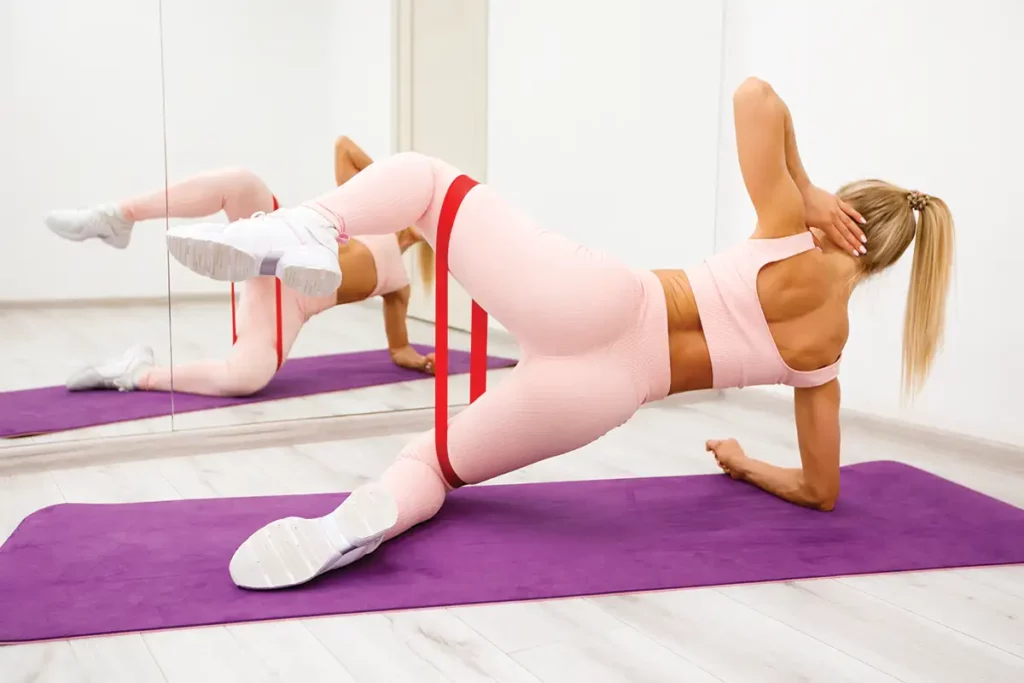If you’ve thought of resistance bands simply as tools for physical therapy, you’ll be interested to know that clients at any fitness level can use them as part of their daily exercise routine. Whether clients are planning to restructure their fitness regimen to kick off the new year, add resistance training at home, or need compact fitness equipment to pack for holiday travel, dietitians can discuss how convenient and easy resistance bands are to use to improve fitness and provide examples of circuit workouts to follow.
Resistance Band Accessibility
Dietetics professionals agree that any form of exercise can contribute positively to health, but cold weather, cost of gym or studio memberships, and space for equipment are common barriers to increasing movement or maintaining a fitness regimen. According to Kelli Kratt-Dunham, RDN, CPT, founder of KKD Nutrition, in Milwaukee, Wisconsin, the versatility and affordability of resistance bands is what makes them such a great recommendation for clients. “Anyone can use them anywhere—whether in your house, at the park, in the gym, or while traveling, and a variety of band strengths allows for variability in resistance for different exercises.”
Kelsey Sackmann, MS, RD, owner of Kelsey P. RD, agrees, adding, “The force it takes to stretch the bands works muscles in ways similar to free weights and machines, offering the same benefits without the need for heavy and expensive equipment.”1 Both Kratt-Dunham and Sackmann emphasize injury prevention benefits as well since bands may put less force on joints while better isolating muscles. Whether supporting a client with osteoarthritis and a tight budget or advanced lifters and athletes, bands can “reduce the risk of injury, build muscle by increasing time under tension, and improve coordination,” Sackmann says.
Improving Fitness
Different types of resistance bands are available from full-length loop bands and tube bands with handles to mini bands. But can they enhance fitness for everyone or just those who are beginning their fitness journey or concerned with injury?
Sackmann says, “Aside from great muscle-building benefits, bands can help build muscular endurance, stability, mobility, balance, and coordination, and provide similar muscle gains when compared to other forms of resistance training. Resistance bands can be pushed and pulled in nearly any way you want while keeping muscles under constant tension, making time spent with them efficient, too.” While individuals at any fitness level can use these bands, high level athletes also use them as a part of their training. Kratt-Dunham says research has shown that the instability and increased load that bands provide are valuable to increase strength while offering more range of motion than is available with many machines or dumbbells.2
Best Candidates for Bands
While resistance bands are suitable for everyone, there are certain populations that may need them most above other activities and forms of equipment.
Low-income populations face the biggest obstacles when choosing to make physical activity a regular habit. They’re concerned with affordability and indoor space constraints as well as outdoor safety during the warmer months. For these individuals, having resistance bands and simple exercise recommendations in hand can make fitness more attainable.
Moreover, postpartum mothers are the perfect candidates for resistance bands as they slowly ease back into fitness routines. After they spend time focusing on appropriate breathing exercises to ensure core and pelvic floor safety following delivery, exercise bands will “allow women to perform low-impact movements that strengthen the core, glutes, and lower back in the comfort of [their] own homes,” Sackmann says. As a new mom herself, Sackmann says resistance bands have “played a pivotal role in my recovery both physically and mentally.”
Kratt-Dunham says resistance bands are great for parents who don’t have time to go to the gym or are new to the gym experience and are uncomfortable working out in front of others. Using resistance bands at home means there’s “a greater chance they will stick with it long term,” Kratt-Dunham says.
Frequent travelers also should have a set of resistance bands that never leaves their suitcase. Even if a hotel has a nice gym, fitting in a quick resistance band circuit before or after a long workday may be more realistic than going to the gym for a full workout.
Older adults may need a safe at-home option, too, if they’re no longer driving, are recovering from injury, or want an alternative to gym attendance to prevent sarcopenia as they age. Sackmann says they’re “fantastic for seniors or those with muscle imbalances who might need a lightweight option.”
Sample Workouts
Sackmann and Kratt-Dunham offer the following circuit workouts RDs can recommend to clients. They both feel these workouts are appropriate for people at any activity level, although individuals who are more fit will use bands with heavier resistance and may choose to do more sets and/or reps than those who are just beginning.
Sackmann provides the following examples of strength circuits clients can perform using long resistance bands with or without handles. The range of repetitions allows for increased repetitions and lower resistance for individuals susceptible to injury or looking to build more muscular endurance.
Circuit 1
(Perform three to four sets of 10 to 20 repetitions for each exercise in both circuits.)
Banded Front Squat: Stand on the middle of the band with feet shoulder-width apart and loop the ends over your shoulders. Cross forearms and perform a squat, keeping your weight back and pushing through your heels on the way up.
Bent-Over Row: Stand on a resistance band with feet hip-width apart, bending forward slightly, and hold both handles below your knee. Squeeze shoulder blades together and row. Lower band and repeat.
Banded Push-Up: Place band around your back, under your arms, and loop it through the palms of your hands. Lower to a plank position, squeeze your core, lower yourself as far as you can without breaking the plank, and push back up.
Circuit 2
Lunge With Overhead Press: Place right foot on the center of the band. With arms bent, hold handles next to your shoulders. Place your left foot behind you, bending both knees at a 90˚ angle. As you come up from the lunge, slowly press band straight overhead. Return your hands to your shoulders before starting the next repetition. Repeat on other side.
Concentrated Bicep Curl: Loop band under both feet. With palms facing the ceiling, hold onto band handles, keeping elbows tucked by your side. Slowly bring your forearms toward your shoulders, and slowly lower back to starting position.
The following two circuits require a resistance band set with an anchor used in a door. Kratt-Dunham recommends resistance to be challenging enough so that 15 reps are a struggle.
Circuit 1
Anchor resistance band at top of door, two handles on ends. (Perform three to four sets of 12 to 15 repetitions for each exercise in both circuits.)
Seated Lat Pulldown: Sit or kneel on the floor facing the door with arms extended, grabbing handles. Bracing your core, pull shoulder blades down and back as you pull the band until it reaches chest level. Pause briefly, squeezing your lats, and slowly return to starting position.
High Row: Stand 3 to 4 feet away, facing door, and position arms straight in front of you, parallel with floor, palms facing down. Keep feet hip-width apart, chest up, and head straight. Brace your core, pull shoulder blades down and back and pull elbows back until they’re even with your shoulders, alongside your body. Pause briefly, squeezing the middle of your back, and slowly return to starting position.
Tricep Pressdown: Stand 1 foot away, facing the door, with feet hip-width apart, chest up, and head straight. With elbows by your sides, bent at 90˚, palms facing down, slowly press down, straightening your arms, keeping them by your sides, squeezing your triceps. Pause briefly at bottom and slowly return to starting position.
Circuit 2
Anchor resistance band in the middle of the door, about door knob height, using two handles on the band.
Standing Row, Palms Facing In: Stand 3 to 4 feet away, facing the door, and position arms straight in front of you, parallel with floor, palms facing down. Keep feet hip-width apart, chest up, and head straight. Brace your core, pull shoulder blades down and back, and pull your elbows back until they’re even with your shoulders, alongside your body. Pause briefly, squeezing the middle of your back, and slowly return to the starting position.
Tricep Kickback: Standing about 3 feet away, facing door, lean forward so your torso is almost parallel to floor. Core braced, with arms by your sides, palms facing in, raise elbows so they are at a 90˚ angle. Moving only your forearms, slowly pull the bands behind you, keeping your upper arms still. Straighten your arms and squeeze your triceps at end of movement. Pause briefly and slowly return to starting position.
Single Arm Row (10 Each Side): Stand 3 to 4 feet away, facing door, and position arms straight out in front of you, parallel with floor, palms facing in. Keep feet hip-width apart, chest up, and head straight. Brace your core, pull your shoulder blades down and back, and pull one elbow back until it’s even with your shoulders, alongside your body. The other arm remains in the starting position. Pause briefly, squeezing through the middle of your back, and slowly return to starting position. Complete all reps on one side before switching to the other.
*If you don’t have handles to attach to your bands, simply grip onto the ends of the band.
— Kelly Jones, MS, RD, CSSD, LDN, is a board-certified specialist in sports dietetics and a media and nutrition communications expert who’s regularly featured in broadcast, print, and digital media. She and her private practice dietitians work with athletes at every level in individual and group settings. Jones also founded and oversees Student Athlete Nutrition.
References
1. Lopes JSS, Machado AF, Micheletti JK, de Almeida AC, Cavina AP, Pastre CM. Effects of training with elastic resistance versus conventional resistance on muscular strength: a systematic review and meta-analysis. SAGE Open Med. 2019;7:2050312119831116.2. Bauer J, Schwiertz G, Muehlbauer T. Effects of an elastic resistance band intervention in adolescent handball players. Sports Med Int Open. 2021;5(2):E65-E72.



